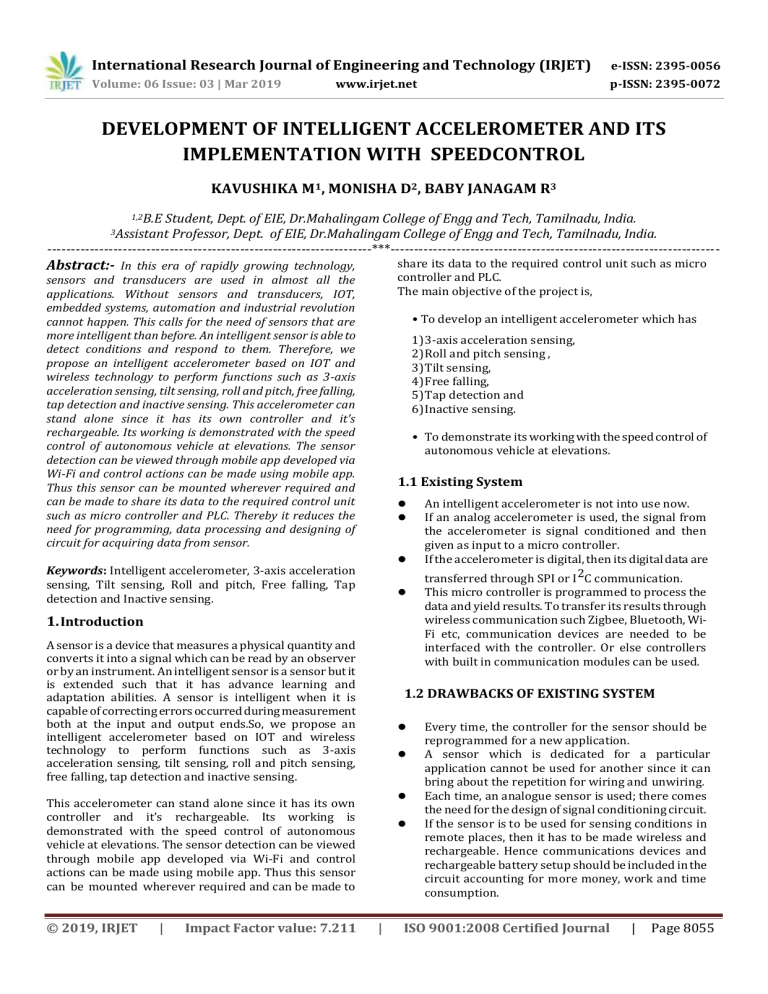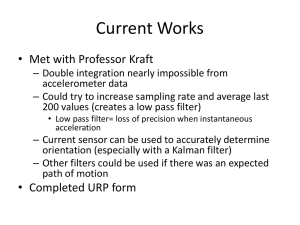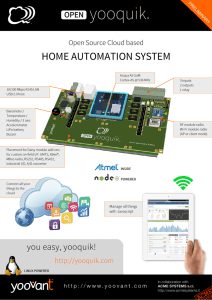IRJET-Development of Intelligent Accelerometer and its Implementation with Speed control
advertisement

International Research Journal of Engineering and Technology (IRJET) e-ISSN: 2395-0056 Volume: 06 Issue: 03 | Mar 2019 p-ISSN: 2395-0072 www.irjet.net DEVELOPMENT OF INTELLIGENT ACCELEROMETER AND ITS IMPLEMENTATION WITH SPEEDCONTROL KAVUSHIKA M1, MONISHA D2, BABY JANAGAM R3 1,2B.E Student, Dept. of EIE, Dr.Mahalingam College of Engg and Tech, Tamilnadu, India. Professor, Dept. of EIE, Dr.Mahalingam College of Engg and Tech, Tamilnadu, India. ---------------------------------------------------------------------***---------------------------------------------------------------------3Assistant Abstract:- In this era of rapidly growing technology, share its data to the required control unit such as micro controller and PLC. The main objective of the project is, sensors and transducers are used in almost all the applications. Without sensors and transducers, IOT, embedded systems, automation and industrial revolution cannot happen. This calls for the need of sensors that are more intelligent than before. An intelligent sensor is able to detect conditions and respond to them. Therefore, we propose an intelligent accelerometer based on IOT and wireless technology to perform functions such as 3-axis acceleration sensing, tilt sensing, roll and pitch, free falling, tap detection and inactive sensing. This accelerometer can stand alone since it has its own controller and it’s rechargeable. Its working is demonstrated with the speed control of autonomous vehicle at elevations. The sensor detection can be viewed through mobile app developed via Wi-Fi and control actions can be made using mobile app. Thus this sensor can be mounted wherever required and can be made to share its data to the required control unit such as micro controller and PLC. Thereby it reduces the need for programming, data processing and designing of circuit for acquiring data from sensor. • To develop an intelligent accelerometer which has 1) 3-axis acceleration sensing, 2) Roll and pitch sensing , 3) Tilt sensing, 4) Free falling, 5) Tap detection and 6) Inactive sensing. • To demonstrate its working with the speed control of autonomous vehicle at elevations. 1.1 Existing System Keywords: Intelligent accelerometer, 3-axis acceleration sensing, Tilt sensing, Roll and pitch, Free falling, Tap detection and Inactive sensing. 1. Introduction A sensor is a device that measures a physical quantity and converts it into a signal which can be read by an observer or by an instrument. An intelligent sensor is a sensor but it is extended such that it has advance learning and adaptation abilities. A sensor is intelligent when it is capable of correcting errors occurred during measurement both at the input and output ends.So, we propose an intelligent accelerometer based on IOT and wireless technology to perform functions such as 3-axis acceleration sensing, tilt sensing, roll and pitch sensing, free falling, tap detection and inactive sensing. | Impact Factor value: 7.211 This micro controller is programmed to process the data and yield results. To transfer its results through wireless communication such Zigbee, Bluetooth, WiFi etc, communication devices are needed to be interfaced with the controller. Or else controllers with built in communication modules can be used. 1.2 DRAWBACKS OF EXISTING SYSTEM This accelerometer can stand alone since it has its own controller and it’s rechargeable. Its working is demonstrated with the speed control of autonomous vehicle at elevations. The sensor detection can be viewed through mobile app developed via Wi-Fi and control actions can be made using mobile app. Thus this sensor can be mounted wherever required and can be made to © 2019, IRJET An intelligent accelerometer is not into use now. If an analog accelerometer is used, the signal from the accelerometer is signal conditioned and then given as input to a micro controller. If the accelerometer is digital, then its digital data are transferred through SPI or I2C communication. | Every time, the controller for the sensor should be reprogrammed for a new application. A sensor which is dedicated for a particular application cannot be used for another since it can bring about the repetition for wiring and unwiring. Each time, an analogue sensor is used; there comes the need for the design of signal conditioning circuit. If the sensor is to be used for sensing conditions in remote places, then it has to be made wireless and rechargeable. Hence communications devices and rechargeable battery setup should be included in the circuit accounting for more money, work and time consumption. ISO 9001:2008 Certified Journal | Page 8055 International Research Journal of Engineering and Technology (IRJET) e-ISSN: 2395-0056 Volume: 06 Issue: 03 | Mar 2019 p-ISSN: 2395-0072 www.irjet.net No blocking diode is required due to the internal PMOSFET architecture and have prevent to negative Charge Current Circuit. Thermal feedback regulates the charge current to limit the die temperature during high power operation or high ambient temperature. The charge voltage is fixed at 4.2V, and the charge current can be programmed externally with a single resistor. The TP4056 automatically terminates the charge cycle when the charge current drops to 1/10th the programmed value after the final float voltage is reached. TP4056 Other features include current monitor, under voltage lockout, automatic recharge and two status pin to indicate charge termination and the presence of an input voltage. 2. HARDWARE COMPONENTS 2.1 ADXL345 The ADXL345 is a small, thin, ultra low power, 3-axis accelerometer with high resolution and a selectable measurement range of ±2 g, ±4 g, ±8 g, or ±16 g. Digital output data is formatted as 16-bit twos complement and is accessible through either a SPI (3- or 4- wire) or I2C digital interface. The ADXL345 is well suited for mobile device applications. It measures the static acceleration of gravity in tilt-sensing applications, as well as dynamic acceleration resulting from motion or shock that allows the device to be used as a tilt sensor.Its high resolution (3.9 mg/LSB) enables measurement of inclination changes less than 1.0°. The sensor is a polysilicon surface-micro machined structure built on top of a silicon wafer. Polysilicon springs suspend the structure over the surface of the wafer and provide a resistance against forces due to applied acceleration. Deflection of the structure is measured using differential capacitors that consist of independent fixed plates and plates attached to the moving mass. Acceleration deflects the proof mass and unbalances the differential capacitor, resulting in a sensor output whose amplitude is proportional to acceleration. Phase-sensitive demodulation is used to determine the magnitude and polarity of the acceleration. Fig -2: TP4056 module 2.4 XL6009 STEP-UP POWER MODULE The XL6009 regulator is a wide input range, current mode, dc/dc converter which is capable of generating either positive or negative output voltages. It can be configured as either a boost, fly back, sepic or inverting converter. The XL6009 built in n-channel power mosfet and fixed frequency oscillator, current-mode architecture results in stable operation over a wide range of supply and output voltages. The XL6009 regulator is special design for portable electronic equipment applications. Fig -1: ADXL345 2.2 BATTERY The battery chosen is 3.7v 1000mAh lithium polymer battery.The battery is used as supply for accelerometer and micro controller. The battery is operated with a switch connection. The battery is fixed within the enclosure to reduce the size of the closed system and to make it compact for mobile applications. Fig -3: XL6009 regulator 2.3 TP4056 MODULE 2.5 AMS1117 3.3V VOLTAGE REGULATOR MODULE The TP4056 is a complete constant-current/constantvoltage linear charger for single cell lithium-ion batteries. Its SOP package and low external component count make the TP4056 ideally suited for portable applications. Furthermore, the TP4056 can work within USB and wall adapter. © 2019, IRJET | Impact Factor value: 7.211 The AMS1117 series of adjustable and fixed voltage regulators are designed to provide up to1A output current and to operate down to 1V input-to-output differential. | ISO 9001:2008 Certified Journal | Page 8056 International Research Journal of Engineering and Technology (IRJET) e-ISSN: 2395-0056 Volume: 06 Issue: 03 | Mar 2019 p-ISSN: 2395-0072 www.irjet.net 2.7 L293D MOTOR DRIVER The dropout voltage of the device is guaranteed maximum 1.3V, decreasing at lower load currents. L293D is a typical Motor driver or Motor Driver IC which allows DC motor to drive on either direction. L293D is a 16-pin IC which can control a set of two DC motors simultaneously in any direction. It means that you can control two DC motors with a single L293D IC. On-chip trimming adjusts the reference voltage to 1.5%. Current limit is set to minimize the stress under overload conditions on both the regulator and power source circuitry. The AMS1117 devices are pin compatible with other threeterminal SCSI regulators and are offered in the low profile surface mount SOT-223 package, in the 8L SOIC package and in the TO-252 (DPAK) plastic package. It works on the concept of H-bridge. H-bridge is a circuit which allows the voltage to be flown in either direction. As you know voltage need to change its direction for being able to rotate the motor in clockwise or anticlockwise direction, Hence H-bridge IC are ideal for driving a DC motor. In a single L293D chip there are two h-Bridge circuit inside the IC which can rotate two dc motor independently. Due its size it is very much used in robotic application for controlling DC motors. Fig -4: XL6009 regulator There are two Enable pins on l293d. Pin 1 and pin 9, for being able to drive the motor, the pin 1 and 9 need to be high. For driving the motor with left H-bridge you need to enable pin 1 to high. And for right H-Bridge you need to make the pin 9 to high. If anyone of the either pin1or pin9 goes low then the motor in the corresponding section will suspend working. It’s like a switch. 2.6 NODE MCU Node MCU is an open source IoT platform. It includes firmware which runs on the ESP8266 Wi-Fi and hardware which is based on the ESP-12 module. The term "Node MCU" by default refers to the firmware that uses the Lua scripting language. A multipoint control unit (MCU) is a device commonly used to bridge videoconferencing connections. The multipoint control unit is an endpoint on the LAN that provides the capability for three or more terminals and gateways to participate in a multipoint conference. NODEMCU which is a ESP8266 Wi-Fi Module is a self-contained SOC with integrated TCP/IP protocol stack that can give any micro controller access to your Wi-Fi network. The ESP8266 is capable of either hosting an application or offloading all Wi-Fi networking functions from another application processor. Fig -6: L293D motor driver 3. BLOCK DIAGRAM NodeMCU board used in our project is Node 1.0 ESP-12E. Fig -7: Block Diagram Fig -5: Node MCU © 2019, IRJET | Impact Factor value: 7.211 | ISO 9001:2008 Certified Journal | Page 8057 International Research Journal of Engineering and Technology (IRJET) e-ISSN: 2395-0056 Volume: 06 Issue: 03 | Mar 2019 p-ISSN: 2395-0072 www.irjet.net 5.2 MOBILE APPLICATION 4. WORKING: In the system of automation sensor data plays a major role in making the system even more user friendly.The sensor data which results in occurance of any acceleration, tilt,roll&pitch, tap,free falling and inactive has been send into Nodemcu . The lithium ion battery was employed to power up the controller remotely without any external power supply.In order to maintain the proper voltage level in controller voltage regulator & boost converter has been installed.Internally powered up controller with inbuilt Wi-Fi will transfers the data to the mobile application through Wi-Fi.The data like acceleration,tilt,roll & pitch which is retrieved in the Mobile application makes the system user friendly,so that the operator need not required much technical skill to operator the system which tend to work automatically. Fig -10: Mobile app 6. CONCLUSION Nodemcu-12E has been connected interior with Nodemcu-32.Whenever the data was sensed from the sensor by nodemcu-12E it keep transferring the data to Nodemcu-32.The motor driver(L2930) has been connected with Nodemcu-32 in order to perform the speed control operation.Whenever the sensor senses the effect of tilt, speed variation has been performed as programmed in nodemcu-32. 5. This project shows acceptable readings of acceleration, tilt, roll and pitch, free fall detection, tap detection and inactive sensing. It has been calibrated to yield accurate results. Our intelligent sensor is compact, small in size and light weight. For demonstration purpose, it has been shown by controlling the speed. The internal control has been modified such a way that the whole control is taken by the NodeMCU. This NodeMCU controls the speed of the DC motor receiving signal from the receiver circuit present in the second NodeMCU. RESULTS AND OBSERVATIONS 5.1 HARDWARE SETUP The intelligent accelerometer communicates with the NodeMCU of remote car wirelessly through Wi-Fi and commands the car to vary its speed according to the tilt angle which is being monitored by the accelerometer. The speed variation happens through the PWM generation of NodeMCU. The required speed for each tilt angle is programmed into the NodeMCU. Thus an Intelligent accelerometer has been developed and its working has been demonstrated with the speed control. REFERENCES 1. Bogdan Muset, ”Distance Measuring using Accelerometer and Gyroscope Sensors “, Simina Emerich Technical University of Cluj-Napoca, Communication Department. 2. David Hanson, ”Monitoring Cattle Motion using 3axis Acceleration and GPS Data “,Changki Mo. School of Mechanical and Materials Engineering, Washington State University Tri-Cities, Received 18 November, 2014. 3. A.Gonzalez,”The use of vehicle acceleration measurements to estimate road roughness“, E.J.O’Brien, Y.Y>Li& K.Cashell. Received 26 May 2007, Published online: 09 May 2008. 4. Alasdair Allan, “Basic Sensors in iOS”, O’Reilly st Media, 1 Edition, 2011. Fig -8: Hardware set up1 Fig -9: Hardware set up2 © 2019, IRJET | Impact Factor value: 7.211 | ISO 9001:2008 Certified Journal | Page 8058



